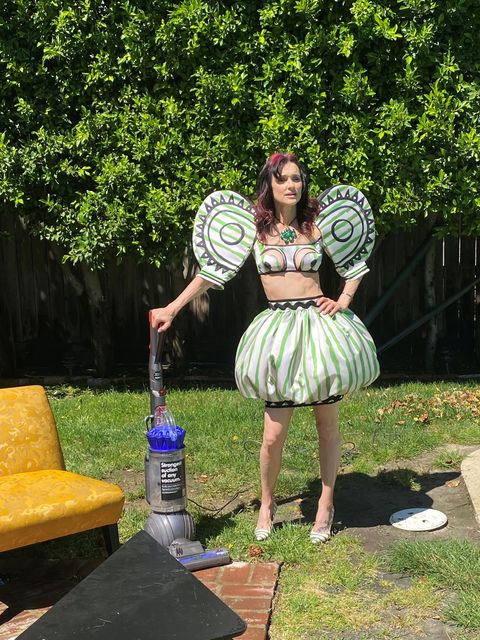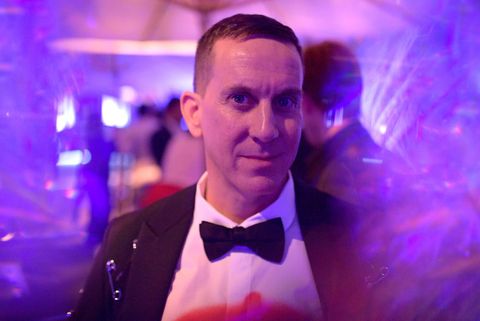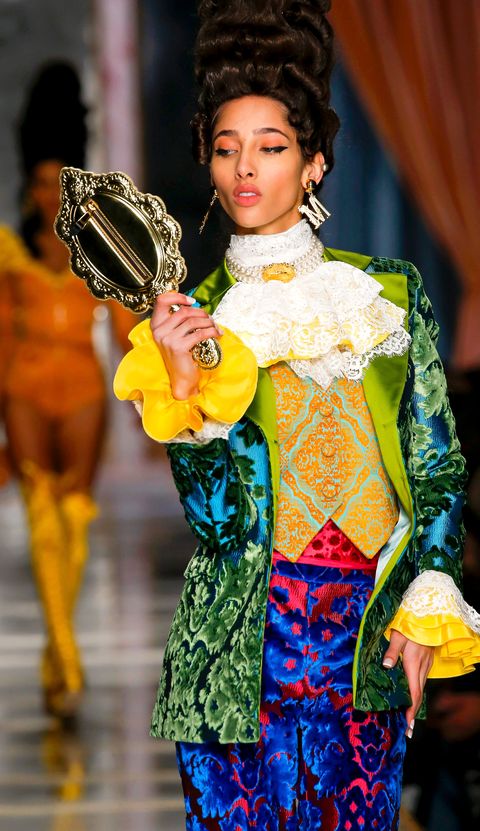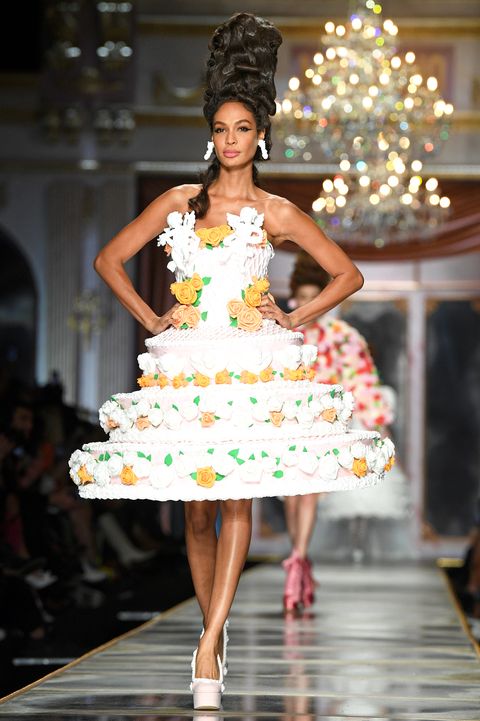When Jeremy Scott began showing in Paris with, as he puts it, “two cents, a shoestring, and a prayer,” he immediately caught the eye of some of the city’s biggest fashion movers and shakers. Twenty-three years later, the designer still clings to that DIY spirit while juggling roles at Moschino, where he has been creative director since 2013, and his eponymous label. Ahead, as part of ELLE’s look at the future of fashion, the designer talks about the creative project he got up to in quarantine in Los Angeles, his abiding love of runway shows (he’s more traditional on this front than you might imagine) and the lessons from the 2008 lessons from the 2008 recession that can be applied to now.
I thought your Moschino at Home project [for which the designer delivered collection items to friends who took self-portraits in the clothes] was so interesting. I love that you included friends of yours who are “regular” people.
It came from a place of wanting to connect with my friends and have a bonding moment and communicate. One of my close friends who’s a mom, she and I hadn’t been able to see each other—we hike or we exercise together a lot and we obviously haven’t been able to do any of that—so I was like, ‘Would you like do something at your house? Just be like, a mom gone crazy, vacuuming the lawn.
I wanted to shine a light on all these women around me that I love, that inspire me, that are a part of my daily life, who do amazing work in one way or another. They are not supermodels, and they’re also not 18 years old. I’m friends with a doctor who’s been my friend since fifth grade. She’s probably the person I’ve known the longest. It was just wonderfully fun to be able to share my world with her. She was like, ‘Oh my goodness, I feel like I’m a model now.’ She got a real kick out of it.
Are these limitations forcing you to be more creative than you normally would?
I always like a box, to be honest with you. I like a challenge, I like a parameter, I like if someone wants to give me an obstacle, because I like boundless creativity and I don’t really put parameters on it. So when there’s an assignment, I like that, because I’m like, ‘Okay, so this is what it’s supposed to fit into. Now watch me shape it so radically different than you could imagine to fit in that box.’
I fundamentally think about creativity like water. You pour it into a glass pitcher, then you can take that pitcher and pour it into a glass to drink out of, or you can pour it into a vase, or you can pour it into a pool, or you can pour it into the cracks in the sidewalk. It’s going to take these forms and shapes no matter what vessel you put them in. And so that’s how I always approach things. So for me, in that respect, it’s not been a challenge. Not saying there haven’t been challenging moments, but the creativity aspect hasn’t really been, because I’m also very DIY. You are talking about someone who started their own company from zero, from scratch, never had an investor, built my name on my own back, did my shows with two cents, a shoestring, and a prayer for many years in Paris. And that was because of being creative and out of the box and having ingenuity. Even going back to what we were talking about just a minute ago—putting the clothes in the car, driving, dropping them off to a friend’s house, giving them some, art direction about why don’t you try this and this and this? It’s really part of my wheelhouse because I have done every job that there is to do, up to the job that I have currently. I look at it differently because of how I’m built.
What have you learned over the last few months that’s influenced your work or that you feel will influence the industry going forward?
For me it’s really a strengthening of what I already believed. I still believe fundamentally, and I’ve always felt it, and I feel like in these times it’s more evident and clear, that originality—work that is emotional, that makes you feel—is important. There is so much stuff that is out in the world already that the only reason you will be motivated or can be motivated to purchase, even to like a picture on Instagram, is, it should give you emotion. It should touch you.
Back in 2008, during the financial crisis, I launched my Adidas collection. It was a global recession and downturn, but it worked because the pieces were unique, they were whimsical, they were special, they were things that people haven’t seen before, they made people feel something. And I think I learned that while everyone was turning to ‘Let’s give them a pair of black pants and a black turtleneck’, that was the wrong move. People don’t need that when things are tough. People don’t need that when money is scarce. What do people need when things are bad? They need optimism. They need joy. They need a reason to want to go on. They need a reason to smile. They need something that puts joy into their heart and hopefully puts it into others’. These are the truths that I hold self-evident; they are my Founding Fathers’ decree: to give something that is strong, that is emotional, that is personal, that sparks joy—to take the phrase from Marie Kondo.
Do you think Fashion Week and the shows themselves could change? What do you envision taking their place?
Well, I’m a little old-school and I think the fashion show itself as a format has endured, at least a century I believe? It’s altered, it’s changed, it’s had different moods, but fundamentally we’ve still gathered together in a room and impossibly tall women walk around, in roughly a circle, wearing the latest designs. If that’s not changed in about a century, why is it going to change? Why is this going to fracture and there’s never going to be a fashion show again? You could probably speak to this better than me because I’m on the other side, but I believe there’s an emotional aspect to watching the show. Or at least certain shows, we’ll leave some others’ names out.
There’s something that happens in that moment that’s different than watching it on a live stream or seeing it in still photos, or seeing it presented in another way. I don’t want to devalue or not give credence to other ideas. I’ve done very experimental shows myself throughout my career, from doing short films that had faux runways and carpet premieres to the film, to peep shows to a whole cheerleading tournament. What I’m trying to say is just that there’s still a human aspect. I still fundamentally believe that going to the movies is an experience, too. It’s a different industry but a similar situation. That watching a film in the dark with a bunch of strangers, there’s an emotional quality, there’s a human connection, there’s something that’s different than even watching it on your TV in the dark at your house. Even if you have a big TV! I think that experience will endure. It may have to take a backseat for a minute.
Diversity and inclusion in the industry is something that people have been talking about for a while, but it only feels more urgent right now. Not just in terms of the shows and campaigns but who is producing the images, who’s behind the camera, who’s on set, who’s in the executive suite, all of that. How has that conversation worked in terms of your work and what do you think the industry has to do moving forward?
I’ve always been very inclusive, before it was even a word. I love beauty in all different shades. That’s just something that has been innate and natural and part of just my view of beauty. The world is beautiful, it is colorful, it is diverse. All of that is very genuine in that respect.
You have been open about how you grew up on a farm and didn’t come from a wealthy background, and you are speaking to all kinds of people. So many things that exist in the fashion industry at large exist to make people feel like they don’t belong, whether it is the way they look or how much money they have. As someone who has had this message of inclusion from the beginning, how do you think the industry needs to change?
I think this is one of the things I didn’t think about. I just did it. Even with the fast-food collection. I know it seems trivial at this point, but I demanded that we do phone cases because it would be something accessible. I wanted to put my arm around more people. I want to be able to bring more people in in whatever capacity works for them: financially, body shape-wise, personality. So it is something that is innate and I don’t know if I can point people in the right direction. I think it just has to be something that you want to do.
What do you want to take away from this time? What traditional ways of operating do you want to leave behind in the pre-COVID era and what things do you want to take away when we are, hopefully, in the post-COVID era?
One thing is, How can we work more efficiently separated? I’m going to have fittings that I won’t be at physically for the first time in my career. I will be watching them on screens and having to do something that I’ve never done before, which is try to change and sculpt the look of the clothes without being in the room. It’ll be an interesting challenge of how that is for me creatively, emotionally, and what that end result is. Maybe it’s efficient? Maybe it’s great? Maybe it’s great because I didn’t just take two flights, being in three different airports, jet lagged and turned upside down, outside of my own comfort zone? maybe I’ll be better? Maybe I’ll be stronger, maybe I’ll have a distance because I’m not in the same room? Maybe I’ll have a drive to try harder than I normally would because I have to focus on the screen and I’m not in the room but could do some other things too while this is going on, I have no idea! You know, it’s all gonna be a new challenge and an individual one for each person who have to experience some of that. To me, the thing that I think will be how we can have these gatherings, in a way that had been physical before that maybe no longer needs to be physical and how that can work.
It’ll be interesting to see if there is a visual language that develops that is recognizably of this time. You were talking about clothes being more emotionally resonant, but I think there’s also going to be a need for them to “pop” even more on a screen than before, because that’s how we will be experiencing them.
Absolutely, and it goes back to what you know best about me in the first place. I’ve been making clothes for Instagram before Instagram existed. Especially when you’re looking at a picture that isn’t too much bigger than the size of your thumbnail, it’s what is going to grab people’s attention or make people emote or feel or think or whatever, there’s a threshold that needs to be surpassed for that. It will definitely have effects. I mean, Instagram alone had effects on fashion! Think about when we first met, talking about that first Moschino collection, there wasn’t as much color in clothes and collections. People were like ‘OMG, it’s blasphemy, there are cartoons going down the runway’ and there are heritage brands who are doing that now, that would have never done that before. It would have been deemed mass market, low level, blah blah blah. More power to everyone because it’s a world that I think is more joyful, but it’s vastly different from the world it was pre-that. I can’t take full responsibility for it. I’m not trying to in any way.
There will be a shift. There will be things that no longer have relevance. There are so many brands that don’t need to show, don’t need to drag everyone in there and clog up the week, clog up people’s timelines, because it will never give you that emotional moment. There are things that do, and all of this will be more evident as the shift happens and the dust settles.
This interview has been edited and condensed for clarity.
Read More On The Future of Fashion
This content is created and maintained by a third party, and imported onto this page to help users provide their email addresses. You may be able to find more information about this and similar content at piano.io




